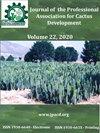Sociocultural and economic significance in the harvest of the pitaya sahuira (Stenocereus montanus) in Sinaloa, Mexico
IF 0.4
4区 农林科学
Q4 HORTICULTURE
Journal of the Professional Association for Cactus Development
Pub Date : 2022-08-17
DOI:10.56890/jpacd.v24i.502
引用次数: 0
Abstract
Pitayas (Stenocereus spp.) are one of the most important wild plants in Mexico; however, there are few studies that evaluate the harvest value and commercialization of local species. This research records the sociocultural and economic importance of the harvest of pitaya sahuira (Stenocereus montanus) in two localities of the state of Sinaloa, Mexico: 1) San José del Llano, Badiraguato, and 2) several small communities in the municipality of Choix. Semi-structured surveys and participatory evaluation were carried out with different people who harvest and market the pitaya fruits during the production season to document the harvest method, productivity, commercial value, fruit destination, cultural perceptions, and the differences between both regions. In both localities, daily harvests are made, and it constitutes the main economic activity during the production season, about 40 to 50 days between May and July. In San José, the harvest is carried out by men and women, while in Choix, it is practically exclusive by men. Higher productivity was recorded in San José, reflected by a greater amount of daily fruit harvested in a workday; however, in Choix, the fruit has a higher sales value, which balances the estimated annual earnings of around 1,940 dollars per harvester (~40,000.00 Mexican pesos). Given its great commercial value, it is necessary to implement cultivation and domestication strategies at the local level, as a regional economic alternative and to reduce the pressure on native populations. This work incorporates additional evidence on the great cultural and economic importance of the genus Stenocereus in Mexico and motivates the design of better strategies for sustainable use and the revaluation of this biocultural heritage.墨西哥锡那罗亚火龙果收获的社会文化和经济意义
Pitayas(Stenocereus spp.)是墨西哥最重要的野生植物之一;然而,很少有研究评估当地物种的收获价值和商业化。这项研究记录了墨西哥锡那罗亚州两个地区收获火龙果(Stenocereus montanus)的社会文化和经济重要性:1)San Josédel Llano、Badiraguato和2)Choix市的几个小社区。对在生产季节收获和销售火龙果的不同人群进行了半结构化调查和参与性评估,以记录收获方法、生产力、商业价值、水果目的地、文化观念以及两个地区之间的差异。在这两个地方,每天都有收成,这是生产季节的主要经济活动,从5月到7月大约有40到50天。在圣何塞,收割由男性和女性进行,而在乔伊克斯,收割实际上是男性独有的。圣何塞的生产力更高,反映在一个工作日每天收获的水果数量更多;然而,在Choix,这种水果的销售价值更高,这与每台收割机约1940美元(约40000.00墨西哥比索)的估计年收入相平衡。鉴于其巨大的商业价值,有必要在地方一级实施种植和驯化战略,作为区域经济替代方案,并减轻当地人口的压力。这项工作结合了更多证据,证明Stenocereus属在墨西哥具有巨大的文化和经济重要性,并推动设计更好的可持续利用战略和重新评估这一生物文化遗产。
本文章由计算机程序翻译,如有差异,请以英文原文为准。
求助全文
约1分钟内获得全文
求助全文
来源期刊

Journal of the Professional Association for Cactus Development
Agricultural and Biological Sciences-Plant Science
CiteScore
1.10
自引率
33.30%
发文量
10
期刊介绍:
The editors of the Journal of the Professional Association for Cactus Development, are very excited to be a part of the excellent editorial committee and to work together to create the synergism between scientists, growers, legislators, and business people so vital to the development of this industry to serve the people of arid lands.
 求助内容:
求助内容: 应助结果提醒方式:
应助结果提醒方式:


